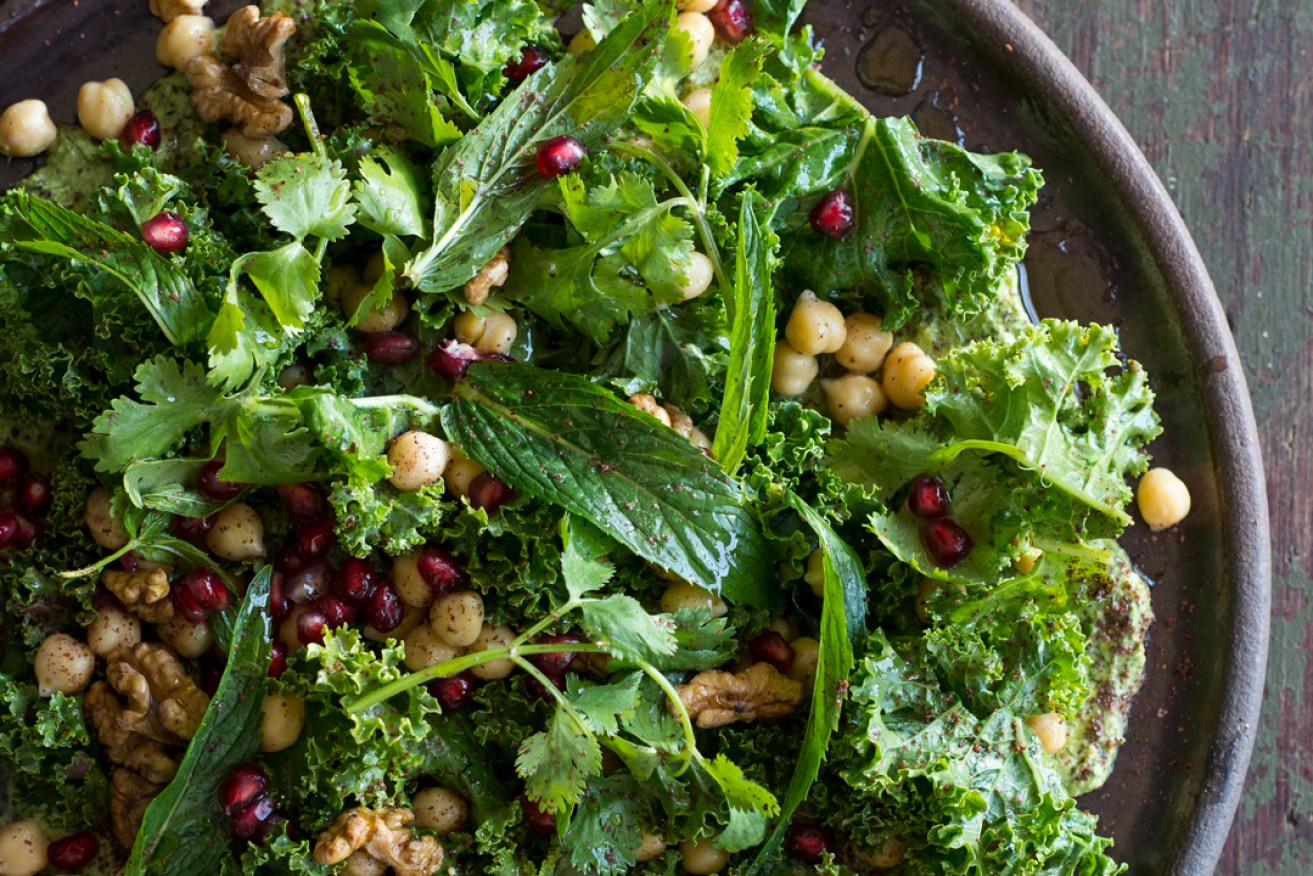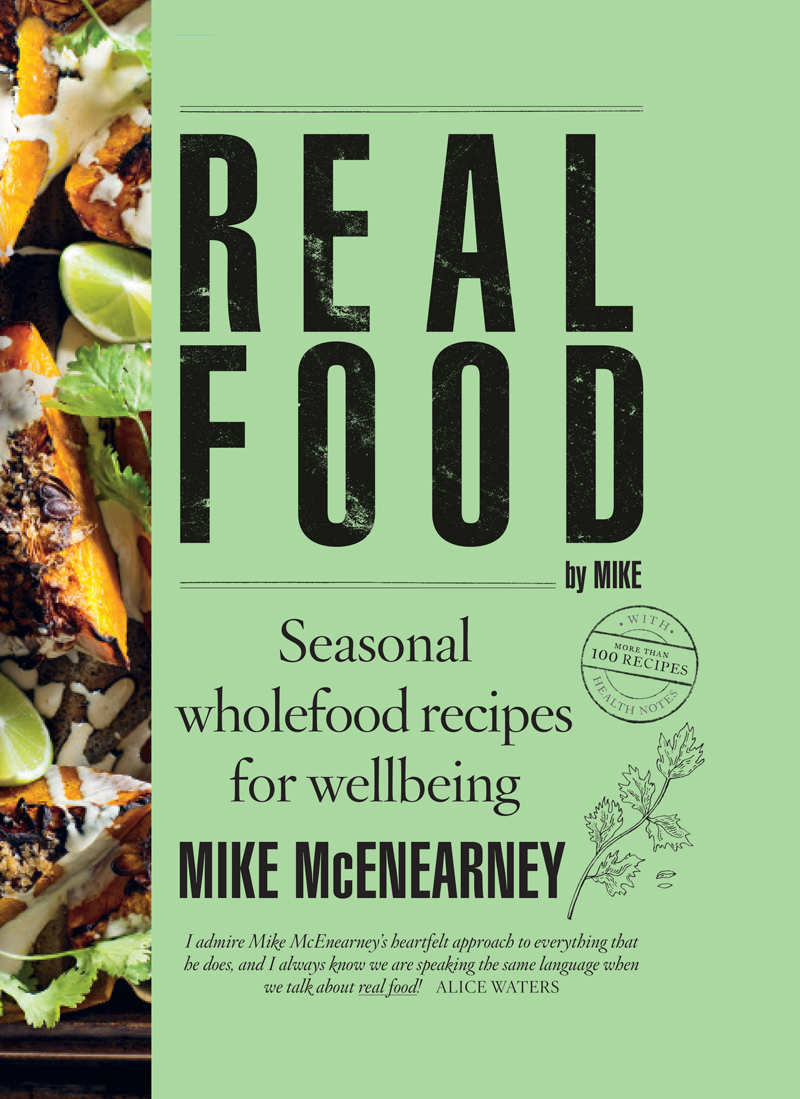Salted kale with chickpeas and green tahini
This tasty kale salad recipe comes from Australian chef Mike McEnearney’s new cookbook of seasonal wholefood recipes inspired by the idea that you are what you eat.

Photography: Alan Benson
Real Food by Mike features recipes for everything from breakfast to sweets and drinks, with accompanying notes listing the nutritional and potential medicinal benefits of ingredients.
McEnearney has worked at London’s Michelin-starred Pied à Terre and headed up the kitchen at Sydney’s Rockpool restaurant before launching his own enterprises No. 1 Bent Street and Mike’s Table.
“When making this salad, always look for the youngest kale possible, as old kale is tougher and harder for the body to digest,” he writes.
“You can make tougher kale more digestible by sprinkling over some salt and lemon juice or apple-cider vinegar and let it sit for 15 minutes before eating.”
Salted kale with chickpeas and green tahini
Serves 4
Ingredients
 1 generous handful activated walnuts
1 generous handful activated walnuts
½ lemon, juiced
1 bunch young kale
200g cooked chickpeas (garbanzo beans), drained
1 handful coriander (cilantro) leaves
1 handful mint leaves
1 tablespoon thinly sliced spring onion (scallion)
1 tablespoon each of black and white sesame seeds, toasted
Seeds from ½ pomegranate
1 tablespoon extra-virgin olive oil
1 pinch sumac
½ quantity green tahini
For Green Tahini:
225g tahini
1 tablespoon crushed garlic
½ teaspoon sea salt
2 lemons, juiced
10g baby English spinach leaves, chopped
100 ml extra-virgin olive oil
½ bunch flat-leaf (Italian) parsley leaves, chopped
½ bunch coriander (cilantro) leaves, chopped
Method
Dehydrate the walnuts until crisp. I’m very lo-fi at home, and we don’t have a dehydrator, so I dehydrate or toast the nuts in the oven at 70C (160F) until crisp – usually overnight works best. If you want to season the nuts, simply soak them in salted water so when they dehydrate they have a nice salty bloom on the surface.
For the green tahini, in a food processor, blend the tahini, 125ml (½ cup) water, the garlic, sea salt, lemon juice and spinach leaves until green and smooth. Blend in the olive oil to emulsify, then fold through the parsley and coriander and pulse to combine. Adjust the salt and lemon juice to taste.
Massage the lemon juice and a pinch of salt into the kale, then let it sit for 15 minutes. Remove the kale from the curing bowl and it will be ready to use. Reserve the juice in the bowl.
In another bowl, toss all your ingredients together, except the tahini and sumac. Add the juice from the curing bowl for more acidity if needed. (If you find lemon too sharp, winter is brimming with lovely citrus to choose from, so perhaps try blood orange juice.)
Smear the green tahini on a serving platter to make a shallow pool. (I find that if you toss the green tahini through the salad, it is too heavy and will crush your lovely leaves.) Place the dressed ingredients on top, sprinkle with the sumac and serve.
Medicinal benefit: brain, heart
Kale has been hailed as a superfood and it’s not hard to see why. Kale contains a bunch of compounds that can help protect against prostate and colon cancers. It’s a rich source of flavanoids, such as beta-carotene, which have strong antioxidant and anti-cancer attributes. It contains vitamin K (essential for blood clotting) and vitamin C (for an immune boost). The nutrients in kale offer protection from vitamin A deficiency, osteoporosis, iron-deficiency anaemia, and are believed to protect from cardiovascular disease.
Chickpeas (garbanzo beans), an ancient food, also have many health-giving attributes. They’re a good source of plant-based amino acids (the building blocks of protein), and are high in fibre, as well as vitamins C and B6 and potassium, which are all supportive of heart health. They’re rich in selenium, which can detoxify cancer-causing compounds in the body, and contain choline, which can help with sleep, learning and memory.
Sesame seeds are particularly rich in the monounsaturated fatty acid oleic acid, which helps lower LDL (‘bad’ cholesterol) and increase HDL (‘good’ cholesterol) in the blood. They are excellent sources of B complex vitamins such as niacin, which also helps reduce LDL-cholesterol levels in the blood. Niacin enhances GABA (a calming neurotransmitter) activity in the brain, which in turn helps reduce anxiety.
This is an edited extract from Real Food By Mike, by Mike McEnearney, published by Hardie Grant Books, RRP $45.




